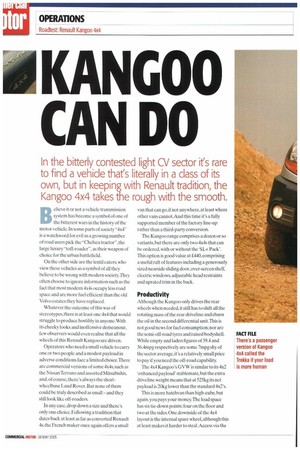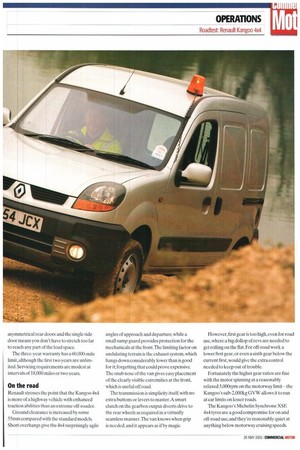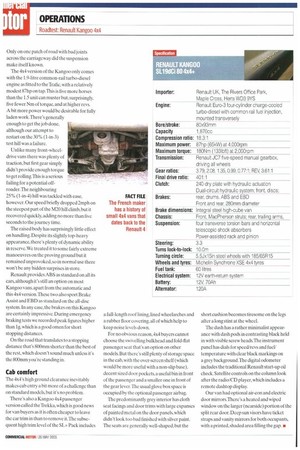KANGOO CAN DO
Page 40

Page 41

Page 42

If you've noticed an error in this article please click here to report it so we can fix it.
In the bitterly contested light CV sector it's rare to find a vehicle that's literally in a class of its own, but in keeping with Renault tradition, the Kangoo 4x4 takes the rough with the smooth.
Believe it or not a vehicle transmission system has become a symbol of one of the bitterest wars in the history of the motor vehicle. In some parts of society "4x4" is a watchword for evil as a growing number of road users pick the -Chelsea tractor", the large luxury -toff-roader", as their weapon of choice for the urban battlefield.
On the other side are the lentil eaters, who view these vehicles as a symbol of all they believe to be wrong with modern society. They often choose to ignore information such as the fact that most modern 4x4s occupy less road space and are more fuel efficient than the old Volvo estates they have replaced.
Whatever the outcome of this war of stereotypes, there is at least one 4x4 that would struggle to produce hostility in anyone. With its cheeky looks and inoffensive demeanour, few observers would even realise that all the wheels of this Renault Kangoo are driven.
Operators who need a small vehicle to carry one or two people and a modest payload in adverse conditions face a limited choice.There are commercial versions of some 4x4s, such as the Nissan Terrano and assorted Mitsubishis, and. of course, there's always the shortwheelbase Land Rover. But none of them could be truly described as small— and they still look like off-roaders.
In any case,drop down a size and there's only one choice. Following a tradition that dates back at least as far as converted Renault 4s. the French maker once again offers a small van that can go, if not anywhere, at least where other vans cannot. And this time it's a fully supported member of the factory line-up rather than a third-party conversion.
The Kangoo range comprises a dozen or so variants, but there are only two 4x4s that can be ordered, with or without the 'SL+ Pack'. This option is good value at £440,comprising a useful raft of features including a generously sized nearside sliding door, over-screen shelf, electric windows, adjustable head restraints and uprated trim in the back.
Produdivity
Although the Kangoo only drives the rear wheels when needed, it still has to shift all the rotating mass of the rear driveline and churn the oil in the second differential unit.This is not good news for fuel consumption; nor are the semi-off-road tyres and raised bodyshell. While empty and laden figures of 39.4 and 36.4mpg respectively are some 7mpg shy of the sector average, it's a relatively small price to pay if you need the off-road capability.
The 4x4 Kangoo's GVW is similar to its 4x2 'enhanced payload' stablemate, but the extra drivefine weight means that at 525kg its net payload is 20kg lower than the standard 4x2's.
This is more hatchvan than high-cube, but again, you pays your money.The load space has six tie-down points: four on the floor and two at the sides. One downside of the 4x4 layout is the internal spare wheel, although this at least makes it harder to steal.Access via the asymmetrical rear doors and the single side door means you don't have to stretch too far to reach any part of the load space.
The three-year warranty has a 60.000-mile limit, although the first two years are unlimited. Servicing requirements are modest at intervals of 18,000 miles or two years.
On the road Renault stresses the point that the Kangoo 4x4 is more of a highway vehicle with enhanced traction abilities than an extreme off-roader.
Ground clearance is increased by some 55rnm compared with the standard models. Short overhangs give the 4x4 surprisingly agile angles of approach and departure, while a small sump guard provides protection for the mechanicals at the front.The limiting factor on undulating terrain is the exhaust systermwhich hangs down considerably lower than is good for it; forgetting that could prove expensive. The snub nose of the van gives easy placement of the clearly visible extremities at the front, which is useful off road.
The transmission is simplicity itself, with no extra buttons or levers to master. A smart clutch on the gearbox output diverts drive to the rear wheels as required in a virtually seamless mannerThe van knows when grip is needed, and it appears as if by magic. However,first gear is too high, even for road use, where a big dollop of revs are needed to get rolling on the flat. For off-road work a lower first gear, or even a sixth gear below the current first, would give the extra control needed to keep out of trouble.
Fortunately the higher gear ratios are fine with the motor spinning at a reasonably relaxed 3,000rpm on the motorway limit — the Kangoo's sub-2,000kg GVW allows it to run at car limits on lesser roads.
The Kangoo's Michelin Synchrone XSE 4x4 tyres are a good compromise for on and off-road use, and they're reasonably quiet at anything below motorway cruising speeds. Only on one patch of road with bad joints across the carriageway did the suspension make itself known.
The 4x4 version of the Kangoo only comes with the 1.9-litre common-rail turbo-diesel engine as fitted to the Trafic, with a relatively modest 87hp on tap.This is five more horses than the 1.5 unit can muster but, surprisingly, five fewer Nm of torque, and at higher revs. A bit more power would be desirable for fully laden work.There's generally enough to get the job done, although our attempt to restart on the 300/ (1-in-3) test hill was a failure.
Unlike many front-wheeldrive vans there was plenty of traction, but first gear simply didn't provide enough torque to get rolling.This is a serious failing for a potential offroader.The neighbouring 25% (1-in-4) hill was tackled with ease, however. Our speed briefly dropped 2mph on the steepest part of the M20 hill climb, but it recovered quickly, adding no more than five seconds to the journey time.
The raised body has surprisingly little effect on handling. Despite its slightly top-heavy appearance, there's plenty of dynamic ability in reserve. We treated it to some fairly extreme manoeuvres on the proving ground but it remained unprovoked, so in normal use there won't be any hidden surprises in store.
Renault provides ABS as standard on all its cars, although it's still an option on most Kangoo vans, apart from the automatic and this 4x4 version.These two also sport Brake Assist and EBD as standard on the all-disc system. In any case, the brakes on this Kangoo are certainly impressive. During emergency braking tests we recorded peak figures higher than lg, which is a good omen for short stopping distances.
On the road that translates to a stopping distance that's 800mm shorter than the best of the rest, which doesn't sound much unless it's the 800mm you're standing in.
Cab comfort
The 4x4's high ground clearance inevitably makes cab entry a bit more of a challenge than on standard models, but it's no problem.
There's also a Kangoo 4x4 passenger version called the Trekka, which is good news for van buyers as it is often cheaper to leave the car trim in than to remove it.The subsequent high trim level of the SL+ Pack includes a full-length roof lining, lined wheelarches and a rubber floor covering, all of which help to keep noise levels down.
For no obvious reason, 4x4 buyers cannot choose the swivelling bulkhead and fold-flat passenger seat that's an option on other models. But there's still plenty of storage space in the cab, with the over-screen shelf (which would be more useful with a non-slip base), decent sized door pockets, a useful bin in front of the passenger and a smaller one in front of the gear lever.The usual glove box space is occupied by the optional passenger airbag.
The predominantly grey interior has cloth seat facings and door trims with large expanses of painted metal on the door panels, which didn't look too bad finished with silver paint. The seats are generally well-shaped, but the short cushion becomes tiresome on the legs after a long stint at the wheel.
The dash has a rather minimalist appearance with dash pods in contrasting black held in with visible screw heads.The instrument panel has dials for speed/revs and fuel/ temperature with clear black markings on a grey background.The digital odometer includes the traditional Renault start-up oil check. Satellite controls on the column look after the radio/CD player, which includes a remote dashtop display.
Our van had optional air-con and electric door mirrors.There's a heated and wiped window on the larger (nearside) portion of the split rear door. Deep sun visors have ticket straps and vanity mirrors for both occupants, with a printed, shaded area filling the gap. •












































































































































































































































